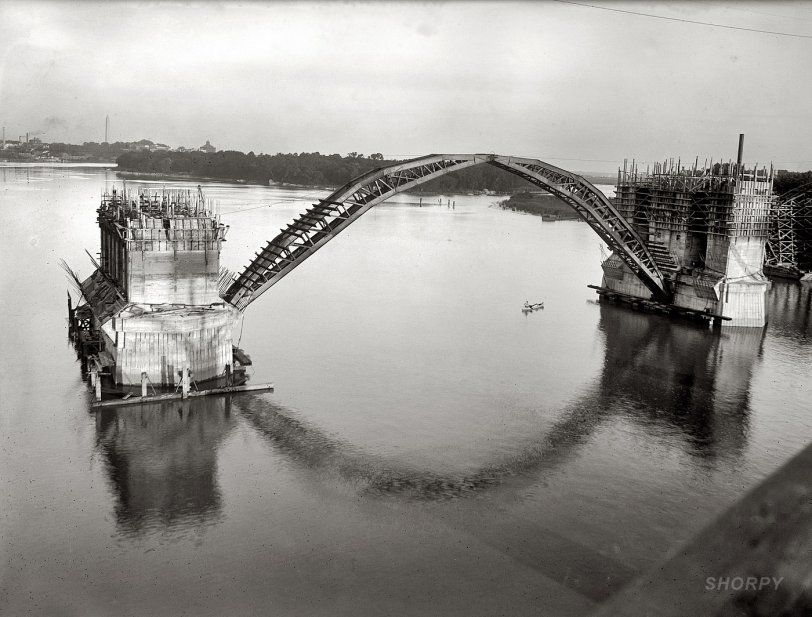


Framed or unframed, desk size to sofa size, printed by us in Arizona and Alabama since 2007. Explore now.
Shorpy is funded by you. Patreon contributors get an ad-free experience.
Learn more.

- Baldwin 62303
- Baldwin VO-1000
- Cold
- No expense spared
- Tough Guys
- Lost in Toyland
- And without gloves
- If I were a blindfolded time traveler
- Smoke Consumer Also Cooks
- Oh that stove!
- Possibly still there?
- What?!?
- $100 Reward
- Freeze Frame
- Texas Flyer wanted
- Just a Year Too Soon
- WWII -- Replacing men with women at the railroad crossing.
- Yes, Icing
- You kids drive me nuts!
- NOT An Easy Job
- I wonder
- Just add window boxes
- Icing Platform?
- Indiana Harbor Belt abides
- Freezing haze
- Corrections (for those who care)
- C&NW at Nelson
- Fallen Flags
- A dangerous job made worse
- Water Stop
Print Emporium
Key Bridge: 1920

The Francis Scott Key Bridge over the Potomac under construction circa 1920. View full size. National Photo Company Collection glass negative.
Bridge to Hell
A native Northern Virginian, I can vouch for the fact that this bridge was the road to freedom when I was coming of age in 1969. The Key Bridge was the link from Rosslyn in Arlington into Georgetown. At the end of that bridge was M Street where the sign atop Dixie Liquor drew one's attention at first glance. Stock, prices, and Virginia Blue Laws made it worth going into the District during the 1950s. Every few weeks my father would pack up the family and head east from Fairfax to buy what was rarely more than a pint. We would wait in our idling car while my father made mad dashes. One unforgettable icy night my mother, brother, and I sat in the car as we often did when the car began to roll back. It was along that very steep brick alleyway that the very famous scene from The Exorcist would one day be filmed. Miraculously the car came to a stop as quickly as it had begun moving. To this day we still chuckle about the night my mother gave strict orders for us not to talk, move, or even breathe heavily. She didn't have to tell us twice! I don't think I ever saw my mother as angry as she was that night. The steam that met my father as he cluelessly slid into the driver's seat was enough to melt all the ice in Alaska!
Bridge Span Placed
The Washington Post, Oct 30, 1920
Key Bridge Span Placed
Second to Be Lowered by Tide Between Abutment and Pier No. 1.
A second steel span, 187 feet long, was lowered in place between the Georgetown abutment and Pier No. 1 of the Key Bridge yesterday morning at 10 o'clock. This span, like the other will be used as a base to build the concrete arches.
The span was erected on a huge float and drawn between the two piers, finally being lowered in place by the falling of the tide. Capt. L. E. Oliver is in charge.
This article doesn't refer to the span pictured (the Georgetown abutment would be at the bank to the left of the photo) but explains the ingenious method of construction which places the span without use of a crane.
Old Key Bridge
The photo is taken from the old Key Bridge, looking southeast. In the background you can see the Washington Memorial. The blur on the bottom right is the railing for the old Key Bridge. Only parts of this structure remain, the north landing in the Chesapeake and Ohio Canal National Park, south of K St NW at "36th St NW" / Whitehurst Fwy. There are also pilings on the Virginia side, west of the bridge. There's no real way to stop on the George Washington Memorial Parkway to see the pilings.
http://maps.live.com/default.aspx?v=2&FORM=LMLTCP&cp=qgh90c8k9qpx&style=...
Potomac?
Doesn't the FSK cross the Patapsco river, not the Potomac?
[It does. And it also crosses the Potomac. There are two Francis Scott Key bridges. - Dave]
[Sorry about the confusion. I'm a Baltimoron and didn't know there was an FSK in Washington, too. -WKH.]
























On Shorpy:
Today’s Top 5